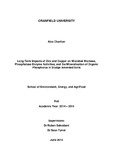JavaScript is disabled for your browser. Some features of this site may not work without it.
| dc.contributor.advisor | Sakrabani, Ruben | |
| dc.contributor.advisor | Tyrrel, Sean | |
| dc.contributor.author | Charlton, Alex | |
| dc.date.accessioned | 2017-08-01T15:33:57Z | |
| dc.date.available | 2017-08-01T15:33:57Z | |
| dc.date.issued | 2015-06 | |
| dc.identifier.uri | http://dspace.lib.cranfield.ac.uk/handle/1826/12259 | |
| dc.description.abstract | The agricultural demand for inorganic phosphate fertilisers needs to be reduced whilst the dependence on more sustainable sources of phosphorus, such as sewage sludge, is increased. However, the presence of heavy metals in sewage sludge pose a threat to soil microorganisms and can inhibit the action of phosphatase enzymes if present in high concentrations. The long-term impact of Zn and Cu on soil microorganisms and phosphatase enzyme activity was investigated at four field sites from the Defra ‘Long-Term Sludge Experiment’ in order to determine the overall impact on organic phosphorus mineralisation. Following the final applications of sludge in 1997, the total concentrations of Zn and Cu at each site were comparable to the UK statutory limits for sludge amended soils. Almost 20 years later 63-91 % of the applied metal loadings still remained and total concentrations of Zn and Cu were found to be significantly higher in contaminated soils, in comparison to untreated soil, and soils receiving uncontaminated sewage sludge. A significant correlation between exchangeable and total metal concentration could still be seen in soils contaminated with Zn, whereas the solubility of Cu was found to be very low (<1 %); though a significant percent remained bound to soil organic matter. No long-term decrease in microbial biomass carbon (Cmic) could be detected in the contaminated soils at any of the sites. However analysis of ergosterol showed an increase in the proportion of microbial biomass carbon derived from fungi. Significant changes were also observed in the PLFA profiles of microbial communities within contaminated soils, indicating the microbial community has adapted and become tolerant to the heavy metal contamination. Combining results using meta-analysis indicated that Zn and Cu caused an increase in fungal biomass carbon of approximately 25-35 % in comparison to soil receiving uncontaminated sludge. Whereas overall decreases of 16 and 8 % were seen for Cmic in soils contaminated with Zn and Cu, respectively, indicating a loss of bacterial biomass from the contaminated soils. Hence, the current UK statutory limits may not be sufficient to prevent changes in soil microbial community and a reduction in the limits set for sludge amended soils is recommended in order to protect microbial diversity. No long-term decrease in the activity of phosphomonoesterase was detectable in the contaminated soils. However combining the results using meta-analysis indicated phosphomonoesterase activity per milligram of biomass carbon was greater in soils contaminated with Cu. This may be an indication that Cu is inhibiting extracellular phosphatase enzyme activity within the soil environment, though this remains undetermined. Orthophosphate, phosphomonoesters, and pyrophosphate were the predominant forms of phosphorus within the applied sludge treatments; a broad phosphodiester signal was also present. Overall, the greatest range of organic phosphorus forms was seen in the uncontaminated sewage sludge. However, no difference in the range of organic phosphorus compounds was observed between the untreated and sludge amended soils at the field sites investigated. It was therefore concluded that the organic phosphorus content of sludge amended soils is returning to that of untreated soil, with no long-term interference caused by the presence of Zn and Cu. | en_UK |
| dc.publisher | Cranfield University | en_UK |
| dc.rights | © Cranfield University, 2015. All rights reserved. No part of this publication may be reproduced without the written permission of the copyright holder. | en_UK |
| dc.title | Long-term impacts of zinc and copper on microbial biomass, phosphatase enzyme activities, and the mineralisation of organic phosphorus in sludge amended soils | en_UK |
| dc.type | Thesis or dissertation | en_UK |
| dc.type.qualificationlevel | Doctoral | en_UK |
| dc.type.qualificationname | PhD | en_UK |
